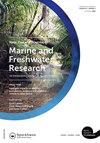Expanding the menu for New Zealand farmed abalone: dietary inclusion of insect meal and grape marc (effects on gastrointestinal microbiome, digestive morphology, and muscle metabolome)
IF 1.7
4区 环境科学与生态学
Q3 FISHERIES
New Zealand Journal of Marine and Freshwater Research
Pub Date : 2023-10-29
DOI:10.1080/00288330.2023.2272592
引用次数: 0
Abstract
Limited supply of sustainable feed ingredients is a significant concern for future aquaculture practices. Alternative ingredients, such as insect meal and grape marc, are suitable for aquaculture nutrition due to their nutritional profile and more sustainable production methods. This study assessed the effect of dietary insect meal and grape marc on gut microbial composition, digestive system morphology, and muscle metabolome of Haliotis iris. Juvenile abalone were fed four encapsulated experimental diets with varying levels of insect meal/grape marc and a commercial feed for 165 days in a commercial farm. The gut health of abalone was evaluated through histopathology, and 16S rRNA amplicon libraries through Illumina MiSeq sequencing. The abalone metabolome was evaluated through gas chromatography-mass spectrometry (GC-MS). Results showed that animals had good intestinal condition across all dietary treatments. Microbiome analysis revealed increased relative abundances of bacteria (Firmicutes and Fusobacterium) associated with the breakdown of polysaccharides in diets including insect meal and grape marc. Metabolite profile variations indicate that the inclusion of insect meal and grape marc favoured fatty acid metabolism and amino acid catabolism, respectively. This study provides foundation to produce more sustainable feeds including insect meal and grape marc without affecting the gut and overall health of abalone.扩展新西兰养殖鲍鱼的菜单:添加昆虫粉和葡萄马克(对胃肠道微生物组、消化形态和肌肉代谢组的影响)
可持续饲料原料供应有限是未来水产养殖实践的一个重大问题。替代成分,如昆虫粉和葡萄渣,由于其营养成分和更可持续的生产方法,适合用于水产养殖营养。本研究评价了饲粮中添加昆虫粉和葡萄渣对虹膜盘尾虫肠道微生物组成、消化系统形态和肌肉代谢组的影响。在某商业养殖场对鲍鱼幼鱼投喂4种不同水平的虫粕/葡萄马克胶囊化试验饲料和1种商品饲料,为期165天。通过组织病理学评估鲍鱼的肠道健康状况,并通过Illumina MiSeq测序评估16S rRNA扩增文库。采用气相色谱-质谱联用技术(GC-MS)对鲍鱼代谢组进行测定。结果表明,在所有饮食处理中,动物的肠道状况良好。微生物组分析显示,细菌(厚壁菌门和梭杆菌门)的相对丰度增加与包括昆虫粉和葡萄渣在内的日粮中多糖的分解有关。代谢物谱的变化表明,虫粕和葡萄marc分别有利于脂肪酸代谢和氨基酸分解代谢。本研究为在不影响鲍鱼肠道和整体健康的前提下,生产更可持续的昆虫粉和葡萄渣饲料奠定了基础。
本文章由计算机程序翻译,如有差异,请以英文原文为准。
求助全文
约1分钟内获得全文
求助全文
来源期刊
CiteScore
4.50
自引率
12.50%
发文量
35
审稿时长
3 months
期刊介绍:
Aims: The diversity of aquatic environments in the southern continents and oceans is of worldwide interest to researchers and resource managers in research institutions, museums, and other centres. The New Zealand Journal of Marine and Freshwater Research plays an important role in disseminating information on observational, experimental, theoretical and numerical research on the marine, estuarine and freshwater environments of the region.

 求助内容:
求助内容: 应助结果提醒方式:
应助结果提醒方式:


